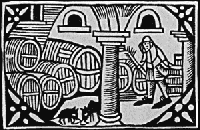After Queen Elizabeth I died in 1603, English Catholics who had been persecuted
under her rule had hoped that her successor, James I, would be more
tolerant of their religion. James I had, after all, had a Catholic mother. Unfortunately,
James did not turn out to be more tolerant than Elizabeth and a number
of young men, 13 to be exact, decided that violent action was the answer.
A small group took shape, under the leadership of Robert Catesby. Catesby felt
that violent action was warranted. Indeed, the thing to do was to blow up the Houses of Parliament. In doing so,
they would kill the King, maybe even the Prince of Wales, and the Members
of Parliament who were making life difficult for the Catholics. Today these
conspirators would be known as extremists, or terrorists.
 To
carry out their plan, the conspirators got
hold of 36 barrels of gunpowder - and stored them in a cellar, just under
the House of Lords.
To
carry out their plan, the conspirators got
hold of 36 barrels of gunpowder - and stored them in a cellar, just under
the House of Lords.
But as the group worked on the plot, it became clear
that innocent people would be hurt or killed in the attack, including some people
who even fought for more rights for Catholics. Some of the plotters started having second thoughts. One of
the group members even sent an anonymous letter warning his friend, Lord
Monteagle, to stay away from the Parliament on November 5th. Was
the letter real?
The warning letter reached the King, and the King's forces made plans to
stop the conspirators.
Guy Fawkes, who was in the cellar of
the parliament with the 36 barrels of gunpowder when the authorities stormed
it in the early hours of November 5th, was caught, tortured and executed.
It's unclear if the conspirators would ever have been able to pull off
their plan to blow up the Parliament even if they had not been betrayed. Some
have suggested that the gunpowder itself was so old as
to be useless. Since Guy Fawkes and the other conspirators got caught before trying
to ignite the powder, we'll never know for certain.
Even for the period which was notoriously unstable, the Gunpowder Plot struck a very profound chord for the people of England.
In fact, even today, the reigning monarch only enters the Parliament once a year, on what is called
"the State Opening of Parliament". Prior to the Opening, and according to custom, the Yeomen of the Guard
search the cellars of the Palace of Westminster.
Nowadays, the Queen and Parliament still observe this tradition.
On the very night that the Gunpowder Plot was foiled, on November 5th, 1605, bonfires were set alight to celebrate the safety of the King.
Since then, November 5th has become known as Bonfire
Night. The event is commemorated every year with fireworks and burning
effigies of Guy Fawkes on a bonfire.
Some of the English have been known to wonder, in a tongue in cheek kind of way, whether they are celebrating
Fawkes' execution or honoring his attempt to do away with the government.



